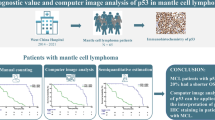Abstract
Conflicting data are reported on the clinical significance of cyclin D1 deregulation in multiple myeloma. The aim of this study was to evaluate the incidence and prognostic significance of cyclin D1 expression and p53 mutations in multiple myeloma, as well as the relationship of their expression with selected clinical data, histological features, and proliferative activity of myeloma cells. We analyzed bone marrow biopsy specimens obtained from 59 patients with newly diagnosed multiple myeloma. Expression of cyclin D1 and p53 was analyzed using standard imunohistochemical method of B5-fixed and routinely processed paraffin-embedded bone marrow specimens. Cyclin D1 was overexpressed in 14/59 (27%) and p53 in 5/59 (8.5%) specimens. There was no significant correlation between cyclin D1 overexpression and age, gender, clinical stage (Durie-Salmon classification), extent of osteolytic lesions, type of monoclonal protein, hemoglobin concentration, platelet count, serum concentration of creatinine, calcium, C-reactive protein, and beta2-microglobulin. No association was observed between the expression of cyclin D1 and the extent of bone marrow infiltration, histological grade, proliferative activity index (measured with Ki-67 immunoreactivity) and response to therapy. No significant difference was observed regarding overall survival between cyclin D1 positive and cyclin D1 negative patients (29 vs 36 mo, p=0.76). Results of this study did not revealed prognostic significance of cyclin D1 overexpression in multiple myeloma. Mutations of p53 gene are rare events in myeloma, suggesting their limited role in the pathogenesis of the disease.
Similar content being viewed by others
References
Pratt G. Molecular aspects of multiple meloma. Mol Pathol 2002;55:273–283.
Hallek M, Bergsagel Pl, Anderson KC. Multiple myeloma: Increasing evidence for a multistep transformation process. Blood 1998;91(1):3–21.
Weinberg RA. The retinoblastoma protein and cell cycle control. Cell 1995;81:323–330.
Hunter T, Pines J. Cyclins and cancer II: cyclin D and CDK inhibitors some of age. Cell 1994;79(4):573–582.
Vogelstein B, Kinzler KW. p53 function and dysfunction. Cell 1992;70:523–528.
Levine AJ. p53, the cellular gatekeeper for growth and division. Cell 1997;88(3):323–331.
Chronic Leukemia-Myeloma Task Force. Guidelines for protocol studies. Cancer Chem Rep 1973;4:145–153.
Durie BG, Salmon SE. A clinical staging system for multiple myeloma. Cancer 1975;36:842–854.
Sailer M, Vykoupil KF, Peest D, Coldewey R, Deicher H, Georgii A. Prognostic relevance of a histologic classification system applied in bone marrow biopsies from patients with multiple myeloma: A histopathological evaluation of biopsies from 153 untreated patients. Eur J Haematol 1995;54:137–146.
Bartl R, Frisch B, Fateh-Moghadam A, Kettner G, Jaeger K, Sommerfeld W. Histologic classification and staging of multiple myeloma. A retrospective and prospective study of 674 cases. Am J Clin Pathol 1987;87:342–355.
Vasef MA, Medeiros LJ, Yospur LS, Sun NC, McCourty A, Brynes RK. Cyclin D1 protein in multiple myeloma and plasmacytoma: an immunohistochemical study using fixed, paraffin-embedded tissue sections. Mod Pathol 1997;10(9):927–932.
Lai MD, et al. Expression of the cell-cycle-related proteins E2F-1, p53, mdm-2, p21waf-1, and Ki-67 in multiple myeloma: correlation with cyclin-D1 immunoreactivity. Mod Pathol 1998;11(7):642–647.
Pruneri G, et al. Immunohistochemical analysis of cyclin D1 shows deregulated expression in multiple myeloma with the t(11;14). Am J Pathol 2000;156:1505–1513.
Athanasiou E, et al. Cyclin D1 overexpression in multiple myeloma. A morphologic, immunohistochemical and in situ hibridization study of 71 paraffin-embedded bone marrow biopsy specimens. Am J Clin Pathol 2001;116(4):535–542.
Hoechtlen-Vollmar W, Menzel G, Bartl R, Lamerz R, Wick M, Seidel D. Amplification of cyclin D1 gene in multiple myeloma: clinical and prognostic relevance. Br J Haematol 2000;109:30–38.
Rasmussen T, Knudsen LM, Johnsen HE. Frequency and prognostic relevance of cyclin D1 dysregulation in multiple myeloma. Eur J Haematol 2001;67:296–301.
Sonoki T, et al. Expression of PRAD1/cyclin D1 in plasma cell malignancy: incidence and prognostic aspects. Br J Haematol 1999;104:614–617.
Wilson CS, et al. Cyclin D1 and E2F-1 immunoreactivity in bone marrow biopsy specimens of multiple myeloma: relationship to proliferative activity, cytogenetic abnormalitis and DNA ploidy. Br J Haematology 2001;112:776–782.
Hinds PW, et al. Mutant p53 DNA clones from human colon carcinomas cooperate with ras in transforming primary rat cells: a comparison of the “hot spot” mutant phenotypes. Cell Growth Different 1990;1(12):571–580.
Neri A, Baldini L, Trecca L, Cro L, Polli E, Maiolo AT. p53 gene mutations in m ultiple myeloma are associated with advanced forms of malignancy. Blood 1993;81(1):128–135.
Ollikainen H, Syrjanen S, Koskela K, Pelliniemi TT, Pulkki K. p53 gene mutations are rare in patients but common in patient-originating cell lines in multiple myeloma. Scand J Clin Lab Invest 1997;57(4):281–289.
Preudhomme C, et al. Rare occurrence of p53 gene mutations in multiple myeloma. Br J Haematol 1992;81(3):440–443.
Author information
Authors and Affiliations
Corresponding author
Rights and permissions
About this article
Cite this article
Markovic, O., Marisavljevic, D., Cemerikic, V. et al. Immunohistochemical analysis of cyclin D1 and p53 in multiple myeloma. Med Oncol 21, 73–79 (2004). https://doi.org/10.1385/MO:21:1:73
Received:
Accepted:
Issue Date:
DOI: https://doi.org/10.1385/MO:21:1:73




